[English] 日本語
 Yorodumi
Yorodumi- EMDB-38732: Structure of CXCR2 bound to CXCL1 (Ligand-receptor focused map) -
+ Open data
Open data
- Basic information
Basic information
| Entry |  | |||||||||
|---|---|---|---|---|---|---|---|---|---|---|
| Title | Structure of CXCR2 bound to CXCL1 (Ligand-receptor focused map) | |||||||||
 Map data Map data | ||||||||||
 Sample Sample |
| |||||||||
 Keywords Keywords | GPCR / Arrestin / SIGNALING PROTEIN-IMMUNE SYSTEM complex | |||||||||
| Function / homology |  Function and homology information Function and homology informationinterleukin-8-mediated signaling pathway / interleukin-8 receptor activity / mast cell granule / interleukin-8 binding / C-X-C chemokine receptor activity / neutrophil activation / C-C chemokine receptor activity / C-C chemokine binding / chemokine activity / Chemokine receptors bind chemokines ...interleukin-8-mediated signaling pathway / interleukin-8 receptor activity / mast cell granule / interleukin-8 binding / C-X-C chemokine receptor activity / neutrophil activation / C-C chemokine receptor activity / C-C chemokine binding / chemokine activity / Chemokine receptors bind chemokines / dendritic cell chemotaxis / Interleukin-10 signaling / cellular defense response / neutrophil chemotaxis / secretory granule membrane / growth factor activity / enzyme activator activity / calcium-mediated signaling / G protein-coupled receptor activity / receptor internalization / specific granule lumen / chemotaxis / mitotic spindle / tertiary granule lumen / nervous system development / microtubule cytoskeleton / positive regulation of cytosolic calcium ion concentration / actin cytoskeleton organization / G alpha (i) signalling events / phospholipase C-activating G protein-coupled receptor signaling pathway / cell surface receptor signaling pathway / intracellular signal transduction / immune response / G protein-coupled receptor signaling pathway / inflammatory response / signaling receptor binding / negative regulation of cell population proliferation / external side of plasma membrane / positive regulation of cell population proliferation / Neutrophil degranulation / negative regulation of apoptotic process / cell surface / signal transduction / extracellular space / extracellular region / nucleoplasm / membrane / plasma membrane Similarity search - Function | |||||||||
| Biological species |  Homo sapiens (human) Homo sapiens (human) | |||||||||
| Method | single particle reconstruction / cryo EM / Resolution: 3.48 Å | |||||||||
 Authors Authors | Sano FK / Saha S / Sharma S / Ganguly M / Shihoya W / Nureki O / Shukla AK / Banerjee R | |||||||||
| Funding support |  India, 1 items India, 1 items
| |||||||||
 Citation Citation |  Journal: Mol Cell / Year: 2025 Journal: Mol Cell / Year: 2025Title: Molecular basis of promiscuous chemokine binding and structural mimicry at the C-X-C chemokine receptor, CXCR2. Authors: Shirsha Saha / Fumiya K Sano / Saloni Sharma / Manisankar Ganguly / Sudha Mishra / Annu Dalal / Hiroaki Akasaka / Takaaki A Kobayashi / Nashrah Zaidi / Divyanshu Tiwari / Nabarun Roy / ...Authors: Shirsha Saha / Fumiya K Sano / Saloni Sharma / Manisankar Ganguly / Sudha Mishra / Annu Dalal / Hiroaki Akasaka / Takaaki A Kobayashi / Nashrah Zaidi / Divyanshu Tiwari / Nabarun Roy / Manish K Yadav / Nilanjana Banerjee / Sayantan Saha / Samanwita Mohapatra / Yuzuru Itoh / Andy Chevigné / Ramanuj Banerjee / Wataru Shihoya / Osamu Nureki / Arun K Shukla /   Abstract: Selectivity of natural agonists for their cognate receptors is a hallmark of G-protein-coupled receptors (GPCRs); however, this selectivity often breaks down at the chemokine receptors. Chemokines ...Selectivity of natural agonists for their cognate receptors is a hallmark of G-protein-coupled receptors (GPCRs); however, this selectivity often breaks down at the chemokine receptors. Chemokines often display promiscuous binding to chemokine receptors, but the underlying molecular determinants remain mostly elusive. Here, we perform a comprehensive transducer-coupling analysis, testing all known C-X-C chemokines on every C-X-C type chemokine receptor to generate a global fingerprint of the selectivity and promiscuity encoded within this system. Taking lead from this, we determine cryoelectron microscopy (cryo-EM) structures of the most promiscuous receptor, C-X-C chemokine receptor 2 (CXCR2), in complex with several chemokines. These structural snapshots elucidate the details of ligand-receptor interactions, including structural motifs, which are validated using mutagenesis and functional experiments. We also observe that most chemokines position themselves on CXCR2 as a dimer while CXCL6 exhibits a monomeric binding pose. Taken together, our findings provide the molecular basis of chemokine promiscuity at CXCR2 with potential implications for developing therapeutic molecules. | |||||||||
| History |
|
- Structure visualization
Structure visualization
| Supplemental images |
|---|
- Downloads & links
Downloads & links
-EMDB archive
| Map data |  emd_38732.map.gz emd_38732.map.gz | 48.2 MB |  EMDB map data format EMDB map data format | |
|---|---|---|---|---|
| Header (meta data) |  emd-38732-v30.xml emd-38732-v30.xml emd-38732.xml emd-38732.xml | 19.8 KB 19.8 KB | Display Display |  EMDB header EMDB header |
| FSC (resolution estimation) |  emd_38732_fsc.xml emd_38732_fsc.xml | 7.9 KB | Display |  FSC data file FSC data file |
| Images |  emd_38732.png emd_38732.png | 107.2 KB | ||
| Filedesc metadata |  emd-38732.cif.gz emd-38732.cif.gz | 6.4 KB | ||
| Others |  emd_38732_half_map_1.map.gz emd_38732_half_map_1.map.gz emd_38732_half_map_2.map.gz emd_38732_half_map_2.map.gz | 48.9 MB 48.9 MB | ||
| Archive directory |  http://ftp.pdbj.org/pub/emdb/structures/EMD-38732 http://ftp.pdbj.org/pub/emdb/structures/EMD-38732 ftp://ftp.pdbj.org/pub/emdb/structures/EMD-38732 ftp://ftp.pdbj.org/pub/emdb/structures/EMD-38732 | HTTPS FTP |
-Validation report
| Summary document |  emd_38732_validation.pdf.gz emd_38732_validation.pdf.gz | 912.7 KB | Display |  EMDB validaton report EMDB validaton report |
|---|---|---|---|---|
| Full document |  emd_38732_full_validation.pdf.gz emd_38732_full_validation.pdf.gz | 912.3 KB | Display | |
| Data in XML |  emd_38732_validation.xml.gz emd_38732_validation.xml.gz | 15.4 KB | Display | |
| Data in CIF |  emd_38732_validation.cif.gz emd_38732_validation.cif.gz | 19.9 KB | Display | |
| Arichive directory |  https://ftp.pdbj.org/pub/emdb/validation_reports/EMD-38732 https://ftp.pdbj.org/pub/emdb/validation_reports/EMD-38732 ftp://ftp.pdbj.org/pub/emdb/validation_reports/EMD-38732 ftp://ftp.pdbj.org/pub/emdb/validation_reports/EMD-38732 | HTTPS FTP |
-Related structure data
| Related structure data |  8xwaMC  8xvuC  8xwfC  8xwmC  8xwnC  8xwsC 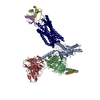 8xwvC  8xx3C  8xx6C  8xx7C  8xxhC  8xxrC 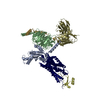 8xxxC M: atomic model generated by this map C: citing same article ( |
|---|---|
| Similar structure data | Similarity search - Function & homology  F&H Search F&H Search |
- Links
Links
| EMDB pages |  EMDB (EBI/PDBe) / EMDB (EBI/PDBe) /  EMDataResource EMDataResource |
|---|---|
| Related items in Molecule of the Month |
- Map
Map
| File |  Download / File: emd_38732.map.gz / Format: CCP4 / Size: 52.7 MB / Type: IMAGE STORED AS FLOATING POINT NUMBER (4 BYTES) Download / File: emd_38732.map.gz / Format: CCP4 / Size: 52.7 MB / Type: IMAGE STORED AS FLOATING POINT NUMBER (4 BYTES) | ||||||||||||||||||||||||||||||||||||
|---|---|---|---|---|---|---|---|---|---|---|---|---|---|---|---|---|---|---|---|---|---|---|---|---|---|---|---|---|---|---|---|---|---|---|---|---|---|
| Projections & slices | Image control
Images are generated by Spider. | ||||||||||||||||||||||||||||||||||||
| Voxel size | X=Y=Z: 1.0375 Å | ||||||||||||||||||||||||||||||||||||
| Density |
| ||||||||||||||||||||||||||||||||||||
| Symmetry | Space group: 1 | ||||||||||||||||||||||||||||||||||||
| Details | EMDB XML:
|
-Supplemental data
-Half map: #1
| File | emd_38732_half_map_1.map | ||||||||||||
|---|---|---|---|---|---|---|---|---|---|---|---|---|---|
| Projections & Slices |
| ||||||||||||
| Density Histograms |
-Half map: #2
| File | emd_38732_half_map_2.map | ||||||||||||
|---|---|---|---|---|---|---|---|---|---|---|---|---|---|
| Projections & Slices |
| ||||||||||||
| Density Histograms |
- Sample components
Sample components
-Entire : C-X-C chemokine receptor type 2 in complex with C-X-C motif chemo...
| Entire | Name: C-X-C chemokine receptor type 2 in complex with C-X-C motif chemokine 1 |
|---|---|
| Components |
|
-Supramolecule #1: C-X-C chemokine receptor type 2 in complex with C-X-C motif chemo...
| Supramolecule | Name: C-X-C chemokine receptor type 2 in complex with C-X-C motif chemokine 1 type: complex / ID: 1 / Parent: 0 / Macromolecule list: all |
|---|---|
| Source (natural) | Organism:  Homo sapiens (human) Homo sapiens (human) |
-Supramolecule #2: C-X-C chemokine receptor type 2
| Supramolecule | Name: C-X-C chemokine receptor type 2 / type: complex / ID: 2 / Parent: 1 / Macromolecule list: #2 |
|---|---|
| Source (natural) | Organism:  Homo sapiens (human) Homo sapiens (human) |
-Supramolecule #3: C-X-C motif chemokine 1
| Supramolecule | Name: C-X-C motif chemokine 1 / type: complex / ID: 3 / Parent: 1 / Macromolecule list: #1 |
|---|
-Macromolecule #1: Growth-regulated alpha protein
| Macromolecule | Name: Growth-regulated alpha protein / type: protein_or_peptide / ID: 1 / Number of copies: 2 / Enantiomer: LEVO |
|---|---|
| Source (natural) | Organism:  Homo sapiens (human) Homo sapiens (human) |
| Molecular weight | Theoretical: 7.877215 KDa |
| Recombinant expression | Organism:  |
| Sequence | String: ASVATELRCQ CLQTLQGIHP KNIQSVNVKS PGPHCAQTEV IATLKNGRKA CLNPASPIVK KIIEKMLNSD KSN UniProtKB: Growth-regulated alpha protein |
-Macromolecule #2: C-X-C chemokine receptor type 2
| Macromolecule | Name: C-X-C chemokine receptor type 2 / type: protein_or_peptide / ID: 2 / Number of copies: 1 / Enantiomer: LEVO |
|---|---|
| Source (natural) | Organism:  Homo sapiens (human) Homo sapiens (human) |
| Molecular weight | Theoretical: 46.699609 KDa |
| Recombinant expression | Organism:  |
| Sequence | String: MGKTIIALSY IFCLVFADYK DDDDAANFTP VNGSSGNQSV RLVTSSSLEV LFQGPGSEDF NMESDSFEDF WKGEDLSNYS YSSTLPPFL LDAAPCEPES LEINKYFVVI IYALVFLLSL LGNSLVMLVI LYSRVGRSVT DVYLLNLALA DLLFALTLPI W AASKVNGW ...String: MGKTIIALSY IFCLVFADYK DDDDAANFTP VNGSSGNQSV RLVTSSSLEV LFQGPGSEDF NMESDSFEDF WKGEDLSNYS YSSTLPPFL LDAAPCEPES LEINKYFVVI IYALVFLLSL LGNSLVMLVI LYSRVGRSVT DVYLLNLALA DLLFALTLPI W AASKVNGW IFGTFLCKVV SLLKEVNFYS GILLLACISV DRYLAIVHAT RTLTQKRYLV KFICLSIWGL SLLLALPVLL FR RTVYSSN VSPACYEDMG NNTANWRMLL RILPQSFGFI VPLLIMLFCY GFTLRTLFKA HMGQKHRAMR VIFAVVLIFL LCW LPYNLV LLADTLMRTQ VIQETCERRN HIDRALDATE ILGILHSCLN PLIYAFIGQK FRHGLLKILA IHGLISKDSL PKDS RPSFV GSSSGHTSTT L UniProtKB: C-X-C chemokine receptor type 2 |
-Experimental details
-Structure determination
| Method | cryo EM |
|---|---|
 Processing Processing | single particle reconstruction |
| Aggregation state | particle |
- Sample preparation
Sample preparation
| Buffer | pH: 7.4 |
|---|---|
| Vitrification | Cryogen name: ETHANE |
- Electron microscopy
Electron microscopy
| Microscope | FEI TITAN KRIOS |
|---|---|
| Image recording | Film or detector model: GATAN K3 (6k x 4k) / Detector mode: COUNTING / Average electron dose: 50.4 e/Å2 |
| Electron beam | Acceleration voltage: 300 kV / Electron source:  FIELD EMISSION GUN FIELD EMISSION GUN |
| Electron optics | Illumination mode: FLOOD BEAM / Imaging mode: BRIGHT FIELD / Cs: 2.7 mm / Nominal defocus max: 1.6 µm / Nominal defocus min: 0.8 µm |
| Sample stage | Specimen holder model: FEI TITAN KRIOS AUTOGRID HOLDER / Cooling holder cryogen: NITROGEN |
| Experimental equipment |  Model: Titan Krios / Image courtesy: FEI Company |
+ Image processing
Image processing
-Atomic model buiding 1
| Initial model | Chain - Source name: SwissModel / Chain - Initial model type: in silico model |
|---|---|
| Refinement | Space: REAL / Protocol: FLEXIBLE FIT |
| Output model |  PDB-8xwa: |
 Movie
Movie Controller
Controller















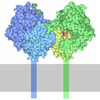
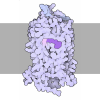
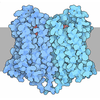


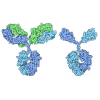




 X (Sec.)
X (Sec.) Y (Row.)
Y (Row.) Z (Col.)
Z (Col.)





































